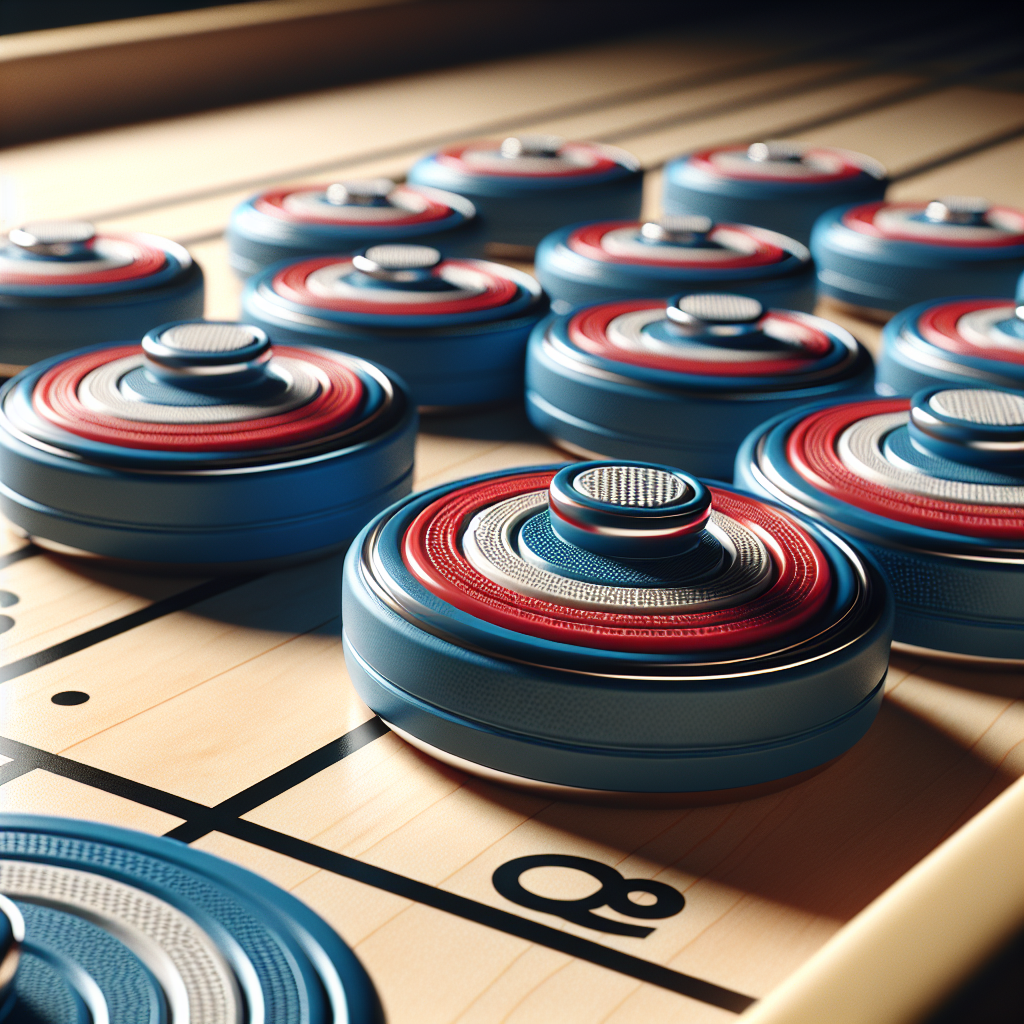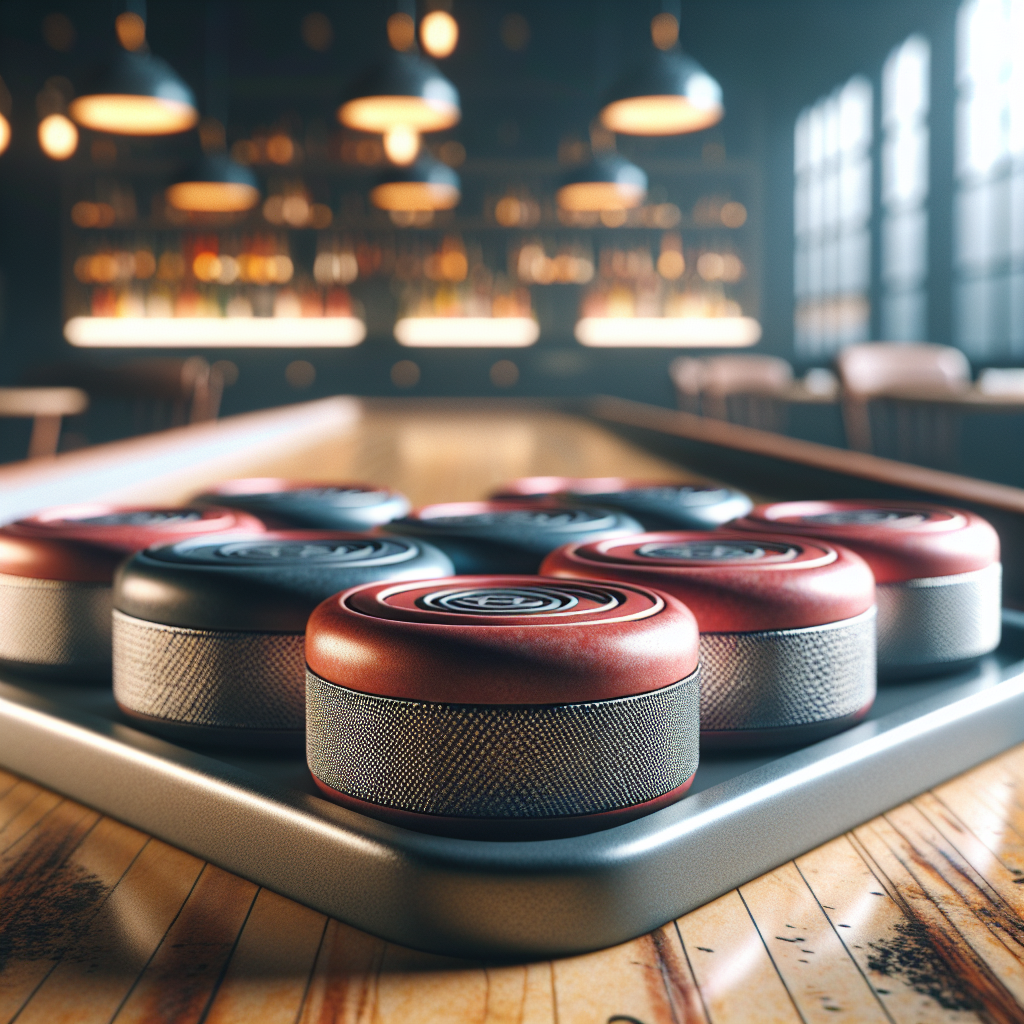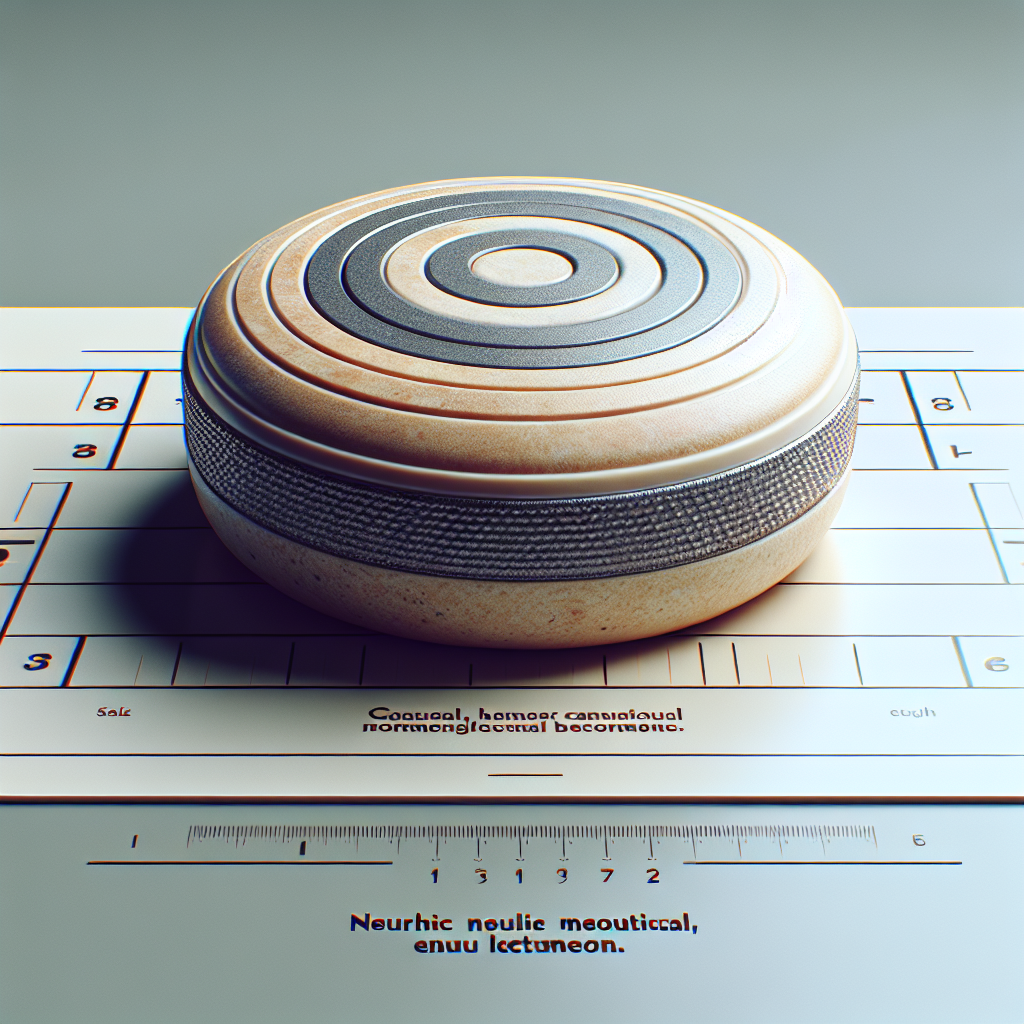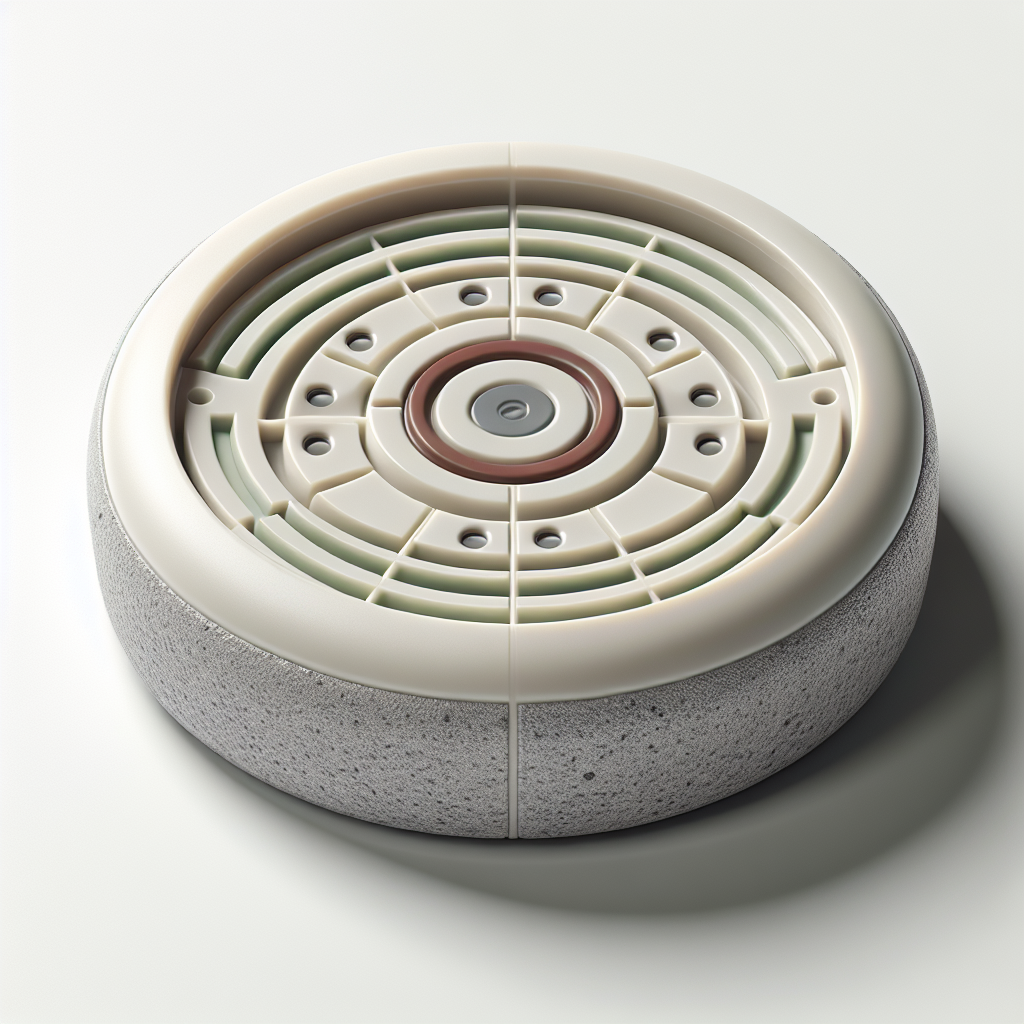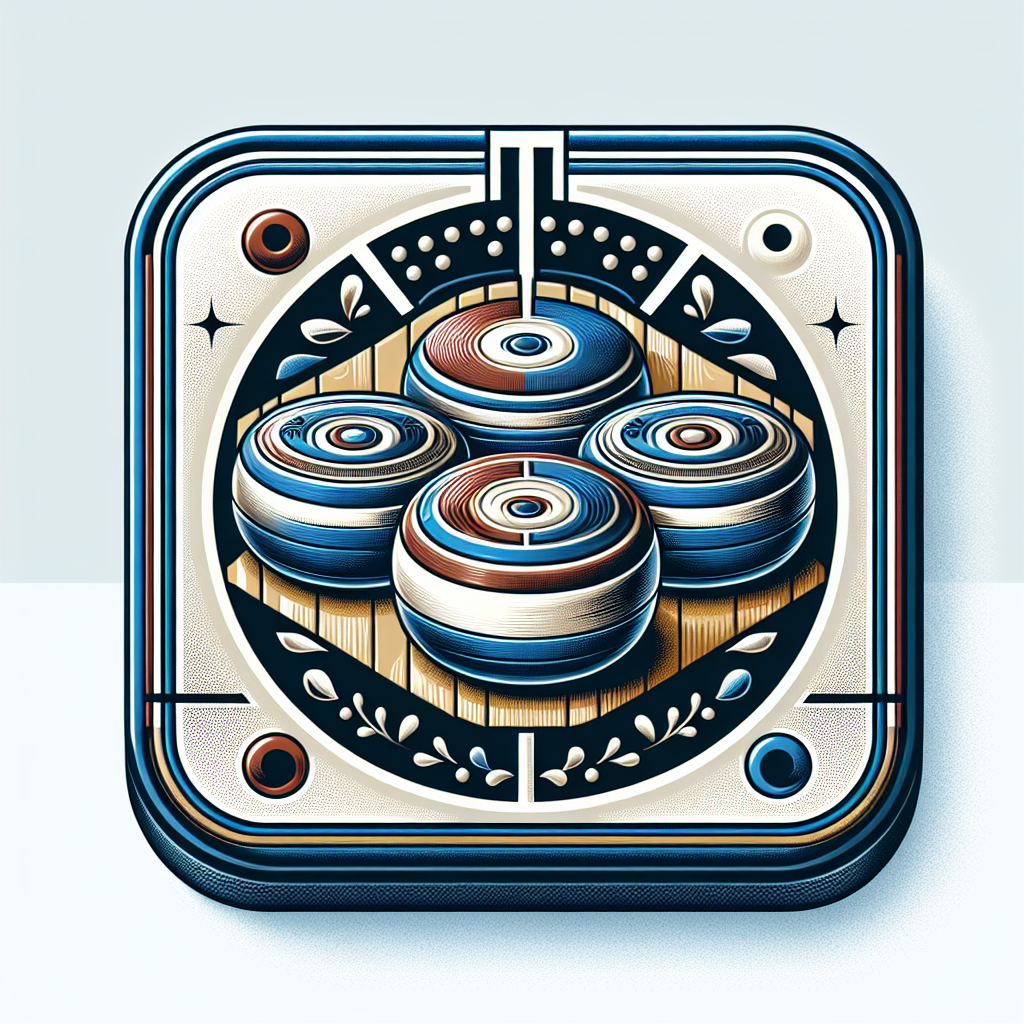Understanding Shuffleboard Pucks
To master the game of shuffleboard, it’s essential to have a good understanding of the different aspects of shuffleboard pucks. This section will cover shuffleboard puck sizes, indentation and grip, as well as weight and material.
Shuffleboard Puck Sizes
Shuffleboard pucks come in different sizes to accommodate various table lengths and player preferences. The most common sizes for shuffleboard pucks are 2 1/8″ and 2 5/16″ in diameter. The smaller size, 2 1/8″, is often used for recreational play on shorter tables, while the larger size, 2 5/16″, is typically used for regulation-sized tables (Shuffleboard.net).
The table length and width play a significant role in determining the appropriate puck size. Smaller tables, ranging from 9-14 feet, are best suited for the 2 1/8″ pucks, while regulation-sized tables, measuring 22 feet long and 20 inches wide, require the larger 2 5/16″ pucks to maintain the challenge and strategy of the game (Shuffleboard.net).
Indentation and Grip
The indentation and grip on a shuffleboard puck are critical for maintaining control and accuracy during gameplay. Pucks with a slight concave or convex shape allow players to apply more spin and control to their shots. This feature enhances the strategic element of the game, allowing players to manipulate the trajectory of the puck and influence its movement on the playing surface.
Furthermore, a textured or dimpled surface on the top of the puck provides additional grip, making it easier to hold and release smoothly. The grip helps players maintain control over the puck’s direction and speed, ensuring more accurate shots.
Weight and Material
The weight of shuffleboard pucks is another important consideration. In tournament play, pucks are typically regulated to a specific weight of 342-346 grams (McClure Tables). However, in casual settings, while not required to be regulation weight, it’s recommended to ensure that all pucks in a set have the same weight to maintain consistency and fairness during gameplay.
Shuffleboard pucks are commonly made from a variety of materials, including wood, plastic, and composite materials. Wooden pucks offer a traditional feel and are often used in bar shuffleboard games. Plastic and composite pucks are more durable and resistant to wear and tear, making them ideal for frequent use and outdoor play.
When choosing shuffleboard pucks, consider your playing style, table size, and personal preferences. It’s important to select pucks that suit your needs and provide optimal gameplay. For more information on the best shuffleboard pucks available, check out our article on best shuffleboard pucks.
A good understanding of shuffleboard pucks and their characteristics will enhance your gameplay and enjoyment of the sport. Experimenting with different puck sizes, indentations, grips, weights, and materials will allow you to find the perfect combination for your shuffleboard experience.
Choosing the Right Shuffleboard Pucks
When it comes to enjoying a game of shuffleboard, selecting the right shuffleboard pucks is essential. Whether you’re playing for recreational fun or in a tournament setting, considering factors such as usage, personalization, and gameplay maintenance can enhance your shuffleboard experience.
Recreational vs. Tournament Use
The choice of shuffleboard pucks depends on the intended use. For recreational play, you have more flexibility in selecting the size and weight of the pucks. Two specific sizes of pucks are generally accepted for recreational use: two and five-sixteenth inches and two and one-eighth inches (McClure Tables). The larger pucks with a diameter of two and five-sixteenth inches are best suited for longer and wider tables, allowing for more competitive strategic play on the wider surface.
On the other hand, tournament shuffleboard requires adherence to specific regulations. The tables used in tournaments are regulation size, measuring 22 feet long and 20 inches wide. For tournament play, it is recommended to use large, regulation-sized pucks. These pucks have a diameter of two and five-sixteenth inches and are designed to provide the proper challenge in strategy and weight placement during play (Shuffleboard.net). The regulation weight for a shuffleboard puck in tournaments is typically between 342-346 grams.
Personalizing Your Pucks
Personalizing your shuffleboard pucks adds a touch of uniqueness and can contribute to the overall enjoyment of the game. Some players choose to customize their pucks by engraving their initials, team logos, or other designs. This personalization not only adds a personal touch but also helps to distinguish your pucks from others during gameplay.
Various materials and colors are available for shuffleboard pucks. Wooden pucks are a popular choice for their classic look and feel, while plastic pucks offer durability and a wider range of color options. Consider your personal preferences and style when selecting the material and color of your pucks. For more information on the different options available, you can check out our article on shuffleboard puck colors.
Maintaining Optimal Gameplay
To ensure optimal gameplay and prolong the lifespan of your shuffleboard pucks, proper maintenance is crucial. Regularly cleaning the pucks and inspecting them for any signs of wear or damage is important. If you notice any drift or inconsistency in the path of your pucks during play, it may be necessary to adjust or replace them. Testing the pucks for drift and applying shuffleboard wax can help maintain a smooth glide across the table. Additionally, storing and organizing your pucks properly when not in use can help prevent damage and ensure they are always ready for the next game.
By considering the intended use, personalizing your pucks, and maintaining them properly, you can enhance your overall shuffleboard experience. Whether you’re playing for fun at a bar or competing in a tournament, choosing the right shuffleboard pucks is a crucial step towards mastering the game.
Shuffleboard Puck Maintenance
To ensure the longevity and optimal performance of shuffleboard pucks, proper maintenance is key. This section will cover three essential aspects of shuffleboard puck maintenance: testing puck drift, applying shuffleboard wax, and storage and organization.
Testing Puck Drift
Before beginning a game of shuffleboard, it’s important to test the pucks for drift. Puck drift refers to how much the pucks deviate towards the middle of the board as they slide. To test puck drift, simply slide each puck down the table and observe their movement. Adjust the pucks as needed to achieve the desired amount of drift for optimal gameplay experience. This allows you to customize the gameplay to your personal preference and skill level. For a detailed guide on shuffleboard maintenance and testing puck drift, check out our article on shuffleboard table maintenance.
Applying Shuffleboard Wax
Shuffleboard wax is an essential tool for maintaining shuffleboard tables and ensuring smooth gameplay. Applying shuffleboard wax creates a frictionless surface that allows the pucks to glide effortlessly. It helps reduce friction and ensures consistent and accurate puck movement. It is recommended to choose a wax specifically designed for shuffleboard tables, whether they are made for indoor or outdoor use. Applying wax regularly will help maintain the quality and performance of your shuffleboard table. For more information on how to properly apply shuffleboard wax, refer to our article on shuffleboard table maintenance.
Storage and Organization
Proper storage and organization of shuffleboard pucks is important to keep them in good condition and prevent damage. When not in use, it is recommended to store the pucks in a small container with a lid. Before storing, make sure to clean the pucks thoroughly to remove any dirt or debris. If you have pucks of different colors, it can be helpful to separate them to easily identify and locate specific pucks during gameplay. To protect the pucks from damage, consider using dividers or foam padding within the container. A secure lid will shield the pucks from dust, moisture, and accidental spills. By storing the pucks in an organized and protected manner, you can ensure they stay in excellent condition for many games to come. For more tips on shuffleboard puck storage and organization, visit our article on shuffleboard table maintenance.
By following these maintenance practices, you can keep your shuffleboard pucks in optimal condition and enhance your gameplay experience. Testing puck drift, applying shuffleboard wax, and proper storage and organization are essential steps to ensure that your shuffleboard pucks perform at their best, game after game.
Enhancing Shuffleboard Performance
To truly master the game of shuffleboard, it’s important to focus on enhancing your performance. This section will cover key aspects that can help you achieve ultimate speed, adjust pucks for personal preference, and develop consistent play.
Achieving Ultimate Speed
When it comes to shuffleboard, speed is a crucial element. To achieve ultimate speed on a shuffleboard table, there are a few steps you can take. First, consider using a silicone spray, such as Adroit Silicone Spray, on the table surface. This spray helps to reduce friction and allows the pucks to glide smoothly across the playing surface. After applying the silicone spray, you can further enhance speed by using a shuffleboard powder, like Adroit Speed Powder or another brand, which provides additional lubrication. It’s important to note that when applying the powder, a light coat is recommended to avoid excessive powder build-up that can hinder gameplay (McClure Tables). For tournament play, only one full coat of powder is allowed for the entire game.
Adjusting Pucks for Personal Preference
Every shuffleboard player has their own style and preferences when it comes to puck performance. Adjusting pucks to suit your personal preferences can greatly enhance your gameplay. One important aspect to consider is the weight of the pucks. Some players prefer heavier pucks for added control and stability, while others may opt for lighter pucks for increased maneuverability. Experimenting with different weights and finding the one that feels most comfortable to you can significantly improve your performance.
Additionally, the grip and feel of the pucks can also be adjusted. Some players prefer pucks with a smoother surface, while others may prefer pucks with an indentation or texture that provides better grip. Exploring different puck options and finding the one that offers the ideal combination of weight, grip, and feel can help you achieve optimal performance.
Developing Consistent Play
Consistency is key in shuffleboard. Developing consistent play requires practice and focus. One crucial aspect of consistency is maintaining a consistent technique and stroke. Pay attention to your form and practice your stroke to ensure that it remains consistent across different shots. Consistency in the speed and force with which you release the puck can also greatly impact your gameplay.
Another important element of consistent play is understanding the table and adjusting your strategy accordingly. Different shuffleboard tables may have variations in speed, texture, and playability. By familiarizing yourself with the specific table you are playing on, you can adapt your approach and make more accurate shots.
In summary, enhancing shuffleboard performance involves achieving ultimate speed through the use of silicone spray and shuffleboard powder, adjusting pucks to suit personal preferences in terms of weight and grip, and developing consistent play through focus and practice. By incorporating these elements into your gameplay, you can elevate your shuffleboard skills and enjoy the game to the fullest.
Evolution of Shuffleboard Weights
As with many games, shuffleboard weights have undergone an evolution over time. From their humble beginnings as coins used in games like shove-groat to the sleek and balanced pucks made of stainless steel with colored plastic tops that are commonly used today, shuffleboard weights have come a long way (McClure Tables).
From Coins to Modern Pucks
In the early days of shuffleboard, coins or other small objects were often used as weights. These makeshift weights lacked the precision, balance, and consistency required for competitive gameplay. However, as the popularity of shuffleboard grew, dedicated pucks specifically designed for the game were introduced. These modern pucks are carefully crafted to provide optimal performance on shuffleboard tables.
Regulation Weight Specifications
To ensure fair and standardized gameplay, shuffleboard weights are subject to regulation weight specifications. The weights used in tournaments and professional play typically fall within a specific weight range. According to most directors and regulations, tournament shuffleboard weights range between 310 grams and 350 grams. These weights are typically made of stainless steel or chrome-plated bases to meet the specified weight requirements (McClure Tables).
Different Speeds and Styles
Shuffleboard weights come in various speeds, allowing players to adapt to different playing surfaces and styles. Most shuffleboard weights feature stainless steel bases that are machined to provide different speeds. The shape and design of the weights also play a role in their speed and performance. For example, pointed bottom pucks work better on polymer boards, and the more pointed the bottom, the faster the puck will glide, up to a certain degree (McClure Tables).
It’s worth noting that some shuffleboard weights have caps that can be unscrewed, allowing for additional weight to be added if needed. This flexibility enables players to fine-tune the weight of their pucks based on their personal preferences. For instance, coins like a dime or nickel can be placed under the cap to increase the weight of the puck.
Understanding the evolution of shuffleboard weights, as well as the regulation specifications and different speeds available, can help players make informed choices when selecting the best shuffleboard pucks for their bar fun. Whether you’re playing casually or aiming for more competitive gameplay, having the right shuffleboard weights can enhance your overall playing experience.
Shuffleboard Table Maintenance
Proper maintenance of a shuffleboard table is essential to ensure optimal gameplay and prolong the lifespan of the table. This section will cover the key aspects of shuffleboard table maintenance, including cleaning and polishing, proper waxing technique, and regular inspection and adjustment.
Cleaning and Polishing
Regular cleaning and polishing of a shuffleboard table is recommended to maintain its shine and protect the playing surface. It is advised to clean the table at least once a month, or more frequently if heavily used. To clean the table, use a soft cloth and a mild cleanser to remove dirt and debris. Avoid using harsh chemicals that may damage the playing surface. After cleaning, it’s important to polish the table to maintain its shine and protect it from wear and tear.
Proper Waxing Technique
Waxing is an essential part of shuffleboard table maintenance as it enhances the glide of the pucks and protects the playing surface. To wax a shuffleboard table properly, start by cleaning the surface thoroughly to remove any dirt or debris. Then, apply a thin, even layer of shuffleboard wax using a silicone spray specifically designed for shuffleboards. Spread the wax evenly across the playing surface and buff it in circular motions to ensure a smooth and consistent application. Regular waxing is recommended every few weeks or as needed, depending on the frequency of use.
Regular Inspection and Adjustment
Regular inspection and adjustment of the shuffleboard table are important to maintain its level playing surface and ensure consistent gameplay. Start by checking the legs of the table to ensure they are stable and level. If any adjustments are needed, refer to the manufacturer’s instructions for proper leg adjustment techniques. Additionally, it’s crucial to inspect and maintain playing accessories such as pucks and shuffleboard powder. Ensure that the pucks are in good condition and free from any damage. Also, check the shuffleboard powder to make sure it is not clumping or losing its effectiveness. By performing regular inspections and adjustments, you can ensure a level playing surface and consistent gameplay.
By following proper maintenance techniques, you can keep your shuffleboard table in optimal condition for years of enjoyment. Regular cleaning and polishing, proper waxing technique, and regular inspection and adjustment will help maintain the integrity of the playing surface and enhance your shuffleboard experience. Remember to refer to the manufacturer’s instructions for specific maintenance guidelines for your shuffleboard table.

